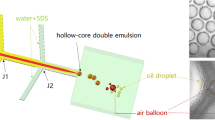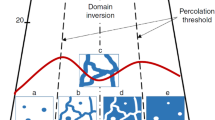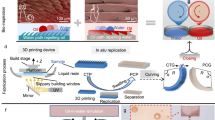Abstract
In the presence of a suitable combination of surfactants (an alkaline metal soap and a medium chain length alcohol, for example), water and oil type organic liquids can form transparent compounds of low viscosity that have been labelled “microemulsions”, with little or no mechanical agitation (spontaneous emulsification) (refs 1–3). Depending on the chemical nature of the surface active agents and the relative constituent proportions, water-in-oil (w/o) or oil-in-water (o/w) systems can be obtained. (Because of the similarity between tertiary solutions of inverted micelles and w/o microemulsions, the term ‘inverted micellar solutions’ has also been suggested4–7.) Microemulsions have been investigated by many scientists interested in liquid state and surface physicochemistry and by many technologists foreseeing numerous applications in industry8,9. It has been suggested9–13 that conductivity and permittivity studies could provide, along with other techniques, valuable information about the structure and phase behaviour of microemulsions which are considered to consist of dispersions between a few tens and a few hundreds of angströms in diameter globules made up of an inner spherical core surrounded by a concentric shell of mixed surfactant and cosurfactant1–10. The experiments reported here show that the conductive behaviour of certain microemulsion systems can be accounted for using the percolation and effective-medium theories14–16 that have depicted transport properties and continuous metal–non-metal transitions in disordered materials with microscopic inhomogeneities associated with, for example, density, composition15 or bonding configuration17 fluctuations. This result, which could help in understanding the structural behaviour of micro-emulsions, is considered in connection with the postulated existence in liquid systems of equilibrium bicontinuous structures, a state described by Scriven18 as ‘related to ordinary liquids as porous media are to homogeneous solids’.
This is a preview of subscription content, access via your institution
Access options
Subscribe to this journal
Receive 51 print issues and online access
$199.00 per year
only $3.90 per issue
Buy this article
- Purchase on SpringerLink
- Instant access to full article PDF
Prices may be subject to local taxes which are calculated during checkout
Similar content being viewed by others
References
Hoar, T. P. & Schulman, J. H. Nature 152, 102–103 (1943).
Prince, L. M. in Emulsions and Emulsion Technology (ed. Lissant K. J.) 125–177 (Dekker, New York, 1974); Microemulsions, Theory and Practice (Academic, New York, 1977).
Mittal, K. L. Micellization, Solubilization and Microemulsions (Plenum, New York, 1977).
Adamson, A. W. J. Colloïd Interface Sci. 29, 261–267 (1969).
Ekwall, P., Mandell, L. & Fontell, K. J. Colloïd Interface Sci. 33, 215–235 (1970).
Friberg, S. & Burasczenska, I. Prog. Colloïd Polymer Sci. 63 1–9.
Sjöblom, E. & Friberg, S. J. Colloïd Interface Sci. 67, 16–30 (1978).
Friberg, S. Infs Chim. 148, 235–238 (1975); Chemtech 6, 124–127 (1976).
Shah, D. O. & Schechter, R. S. Improved Oil Recovery by Surfactant and Polymer Flooding (Academic, New York, 1977).
Shah, D. O. & Hamlin, R. M. Science 171, 483–485 (1971).
Clausse, M., Sheppard, R. J., Boned, C. & Essex, C. G. in Colloïd Interface Science Vol. 2 (ed. Kerker, M.) 233–234 (Academic, New York, 1976).
Peyrelasse, J., Boned, C., Xans, P. & Clausse, M. in Emulsions, Latices and Dispersions (eds Becher, P. & Yudenfreund, M. N.) 221–236 (Dekker, New York, 1978).
Clausse, M. in Encyclopedia of Emulsion Technology (ed. Becher, P.) (Dekker, New York, in the press).
Kirkpatrick, S. Phys. Rev. Lett. 27, 1722–1725 (1971); Rev. mod. Phys. 45, 574–588 (1973).
Cohen, M. H. & Jortner, J. Phys. Rev. Lett. 30, 696–698 (1973).
Webman, I., Jortner, J. & Cohen, M. H. Phys. Rev. B11, 2885–2892 (1975).
Cabane, B. & Friedel, J. J. Phys., Fr. 32, 73–84 (1971).
Scriven, L. E. Nature 263, 123–125 (1976); in Micellization, Solubilization and Microemulsions Vol. 2 (ed. Mittal, K. L.) 877–893 (Plenum, New York, 1977).
Lagües, M., Ober, R. & Taupin, C. J. Phys. Lett., Fr. 39, L487–491 (1978).
Bruggeman, D. A. G. Ann. Phys. 24, 636–679 (1935).
Bottcher, C. J. F. Rec. Trav. Chim. 64, 47–51 (1945).
Landauer, R. J. appl. Phys. 23, 779–784 (1952).
Dvolaitzky, M. et al. J. Chem. Phys. 69, 3279–3288 (1978).
Peyrelasse, J., McClean, V. E. R., Boned, C., Sheppard, R. J. & Clausse, M. J. Phys. D: Appl. Phys. 11, L117–121 (1978).
Talmon, Y. & Prager, S. Nature 267, 333–335 (1977); J. chem. Phys. 69, 2984–2991 (1978).
Author information
Authors and Affiliations
Rights and permissions
About this article
Cite this article
Lagourette, B., Peyrelasse, J., Boned, C. et al. Percolative conduction in microemulsion type systems. Nature 281, 60–62 (1979). https://doi.org/10.1038/281060b0
Received:
Accepted:
Published:
Issue date:
DOI: https://doi.org/10.1038/281060b0
This article is cited by
-
Transport Phenomena in Reverse Micelles: An Overview on Electrical Conductivity, Viscosity, Dielectric Constant, Diffusion Coefficient and Heat apacity
Chemistry Africa (2022)
-
Study on extraction of cobalt(II) by sodium laurate/pentan-1-ol/heptane/NaCl microemulsion system
Journal of Radioanalytical and Nuclear Chemistry (2018)
-
Incorporation of Antitubercular Drug Isoniazid in Pharmaceutically Accepted Microemulsion: Effect on Microstructure and Physical Parameters
Pharmaceutical Research (2008)
-
Microstructure and structural transition in palm-kernel oil microemulsion using 1.5-order differential electroanalysis
Colloid and Polymer Science (2007)
-
DSC spectra as thermal fingerprints of percolative microemulsions
Journal of Thermal Analysis and Calorimetry (1998)



